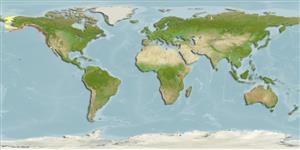Common names from other countries
Classification / Names / Names
ชื่อสามัญ | ชื่อพ้อง | Catalog of Fishes (gen., sp.) | ITIS | CoL | WoRMS
Environment: milieu / climate zone / depth range / distribution range
นิเวศวิทยา
; ระดับความลึก 0 - 60 m (Ref. 95344). Subtropical
Eastern Pacific and the Arctic: Alaska to California. Subtropical to boreal.
Length at first maturity / ขนาด / น้ำหนัก / Age
Maturity: Lm ? range ? - ? cm Max length : 9.0 cm SHL เพศผู้/กระเทย; (Ref. 865); common length : 8.0 cm SHL เพศผู้/กระเทย; (Ref. 312)
Description: Shell has spiral ridges. Has at least three prominent wing-like structures, worn off in older snails. Color is brown and white to creamy-white. Young snails have tooth-like projections on the lip of the shell (Ref. 312).
Occurs in the low intertidal zone. Uses the radula to bore through the calcareous shells of its prey (clams, mussels, and barnacles; Ref. 312) (Ref. 312).
Life cycle and mating behavior
วัยเจริญพันธุ์ | การสืบพันธุ์ | การวางไข่ | เซลสืบพันธ์ของเพศเมีย(ไข่) | ความดกของไข่ | ตัวอ่อน
This species is a non-broadcast spawner. Life cycle does not include trocophore stage. Also Ref. 833.
Gallivan, G. and J. Danforth. 1999. (Ref. 312)
IUCN Red List Status (Ref. 130435)
CITES status (Ref. 108899)
Not Evaluated
Not Evaluated
Human uses
| FishSource |
เครื่องมือ
ข้อมูลเพิ่มเติม
Age/SizeการเจริญเติบโตLength-weightLength-lengthสัณฐานวิทยาตัวอ่อนอุดมสมบรูณ์
แหล่งที่มาจากอินเตอร์เน็ต
Estimates based on models
Preferred temperature
(Ref.
115969): 5.7 - 12, mean 8.9 (based on 132 cells).
Price category
Unknown.
